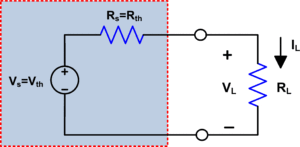Table of Contents
Maximum Power Transfer Theorem
The Maximum Power Transfer Theorem is a fundamental principle in electrical engineering, particularly in the field of network theory. It states that the maximum amount of power is delivered from a source to a load when the load resistance is equal to the source resistance as seen from the load’s perspective. Here is a detailed explanation:
Statement of the Theorem
For maximum power transfer, the load resistance \( R_L \) must equal the Thevenin resistance \( R_{th} \) of the source network supplying the power. Mathematically, this is expressed as:
\( R_L = R_{th} \)
Thevenin’s Equivalent Circuit
To apply the Maximum Power Transfer Theorem, the source network is often simplified using Thevenin’s theorem. This involves representing the entire network by a single voltage source \( V_{th} \) in series with a resistance \( R_{th} \). The steps are as follows:
- Find the Thevenin Voltage \( V_{th} \): This is the open-circuit voltage at the terminals where the load is connected.
- Find the Thevenin Resistance \( R_{th} \): This is the equivalent resistance seen from the load terminals with all independent sources turned off (voltage sources replaced by short circuits and current sources by open circuits).
Proof of the Maximum Power Transfer Theorem
Consider a circuit with a Thevenin equivalent source connected to a load resistor \( R_L \):

Voltage across the load \( V_L \): Given by the voltage divider rule:
\( V_L = V_{th} \left( \frac{R_L}{R_{th} + R_L} \right) \)
Power delivered to the load \( P_L \): Given by:
\( P_L = V_L^2 / R_L = \left( \frac{V_{th} R_L}{R_{th} + R_L} \right)^2 / R_L \)
Simplifying this:
\( P_L = \frac{V_{th}^2 R_L}{(R_{th} + R_L)^2} \)
To find the maximum power, take the derivative of \( P_L \) with respect to \( R_L \) and set it to zero:
\( \frac{dP_L}{dR_L} = 0 \)
Differentiating:
\( \frac{d}{dR_L} \left( \frac{V_{th}^2 R_L}{(R_{th} + R_L)^2} \right) = 0 \)
Through calculus, it can be shown that this derivative equals zero when:
\( R_L = R_{th} \)
Maximum Power Delivered
When \( R_L = R_{th} \), the maximum power transferred to the load is:
\( P_{max} = \frac{V_{th}^2}{4 R_{th}} \)
This result shows that when the load resistance is matched to the source resistance, the power transferred is maximized and equals a quarter of the square of the Thevenin voltage divided by the Thevenin resistance.
Practical Considerations
- Efficiency: While the theorem ensures maximum power transfer, it does not guarantee maximum efficiency. When \( R_L = R_{th} \), the efficiency is only 50% because half the power is dissipated in the source resistance.
- Impedance Matching: In AC circuits, the theorem applies to impedance rather than resistance. For maximum power transfer, the load impedance should be the complex conjugate of the source impedance.
In summary, the Maximum Power Transfer Theorem is crucial for designing and optimizing circuits, ensuring that power delivery to the load is maximized under specific conditions.